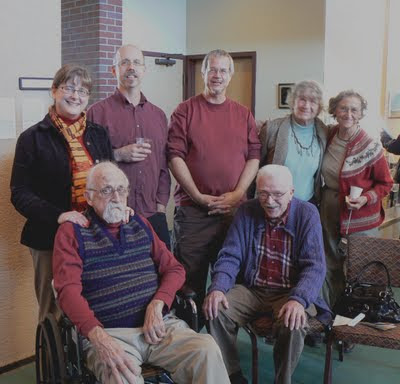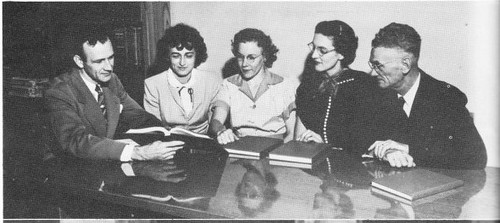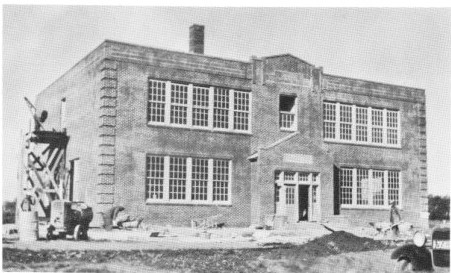Every year, St John Church put on a huge Christmas Eve service in Seward High School's gymnasium. The entire congregation (and, I think, a lot of Seward citizens who did not usually attend our church) attended the one Christmas Eve service.
At one end of this gymnasium was a stage, on which the Christmas story was enacted. The students who sang badly were assigned to play the roles of Joseph and Mary, the angels, the shepherds, and so forth. (This would have been my own fate if I had not received individual, remedial singing lessons from Ms. Bartels in fourth grade.)

At the foot of the stage, there was a brass band, and some of the singing was accompanied by students playing trumpets, trombones, etc. (In the picture below, I am the trombonist on the right.)

The entire gymnasium floor was covered by canvas, and folding chairs were set up. The St John School students sat on the bleachers on one side of the gymnasium (on the right side, as you looked at the stage), and the congregation sat on the folding chairs on the gymnasium floor and on the bleachers on the other side of the gymnasium. I would guess that total number of people participating in the service in the gymnasium was more than a thousand.
The students on the bleachers were arrayed by class. The lowest classes were closest to the stage, and the older classes were progressively farther from the stage. All the students were dressed in choir robes. The younger classes wore white robes with big, red bow ties ...

... and the oldest classes wore black and white robes. (The above picture of the brass band shows those robes.)
During my years at St John (1960-1966), the student body numbered about 350. The Seward kids who did not attend St John School but who were enrolled in confirmation classes also participated in the service, so the total number of students participating in the service approached 400. Practically all of these students sat on the bleachers and sang in the choirs; only a few played roles on the stage.
The service lasted for about an hour, probably from about 8 to 9 o'clock. The largest portion of that time was spent on choir singing. The Christmas story was read aloud from the Bible, and songs were sung between portions of the story. The pastor's sermon was quite short, and the service did not include communion.
The songs were sung by groups of classes. I don't remember exactly, but some songs were sung by grades 1-3, some by grades 4-6 and some by grades 7-8. A few of the songs were accompanied by the brass band.
St John School provided an excellent music education -- especially in choral singing -- and the students rehearsed the program's Christmas songs during the four Advent weeks that preceeded Christmas Eve. Basically the same songs were sung every year, so the students knew and sang all the songs very well. The program included a couple dozen songs.
One song that I remember in particular was The Drummer Boy, which was sung by the seventh and eighth grades. The boys whose voice had deepened were grouped to sing the pa-rumpa-pa-pa part at lower tones, so essentially the boys were grouped by their puberty progress -- and that was embarrassing for me.
The costumes were issued to the students several days before Christmas eve. I think this was done on in the St John School gymnasium on a school day. Each student was given a costume that fit his size, and the student took the costume home and then wore it to the program. We never rehearsed in the Seward High School gymnasium; we went to that gymnasium only for the Christmas Eve program itself.
After the service ended and as we were exiting the gymnasium, every student received a paper bag full of peanuts, popcorn balls, candy and an orange. Then our parents would torment their children by driving all around Seward looking at Christmas lights and displays instead of rushing home to open their Christmas presents as soon as possible.
I always enjoyed participating in this Christmas Eve program, and I remember it as an impressive performance. All the Christmas Eve programs that I have attended since I left Seward have been far below that performance standard. I also imagine that the Christmas Eve programs that are performed now are below the performance standard that we experienced in the 1960s.
During the first three decades that followed my departure from Seward, I had recurring dreams about those Christmas Eve services in the Seward High School gymnasium. The common element of these dreams was I was standing on the canvas-covered gymnasium floor during the program, and then suddenly the building turned upside down, so that I was suspended upside-down from the floor that had become the ceiling. Somehow my feet stuck to this ceiling, and so I did not fall down, but I was terrified of falling down onto my head. At this point in my dream, I would wake up, and so I would remember the dream clearly.
I don't know the cause or meaning of this dream. I suppose that as an elementary-school student I had felt some anxiety about going to that unfamiliar gymnasium to participate in that service. I had felt that something might go wrong and that the unfamilar surroundings would compound the problem. Then this dream became symbolic for other anxieties that I felt in later situations, and so the dream recurred for many years. I suppose the last time I remember the dream happening was about 15 years ago.
Steve Sylwester added:
Mike has forgotten about the Christmas Eve morning rehearsal at the Seward Public School gym, and he has failed to mention the unison recitations of Bible verse passages done by the different St. John's Lutheran School grades at times throughout the program.
Also, Koe and I remember that the school choirs were in the bleachers on both sides of the gym, not just one side. Lastly, I think Mike exaggerates in his imagination of how the stage actors were selected.
Jody (Schwich) Marquardt added:
I remember kids throwing up down in those “tunnels” (hallways, I guess) while we waited in our white robes (it was hot and stuffy!). That was probably 4th or 5th grade in the old Seward High gym —- 1959 or 1960.
I think Steven is right that students sat almost to the top on both sides.
I also remember the paper bags of candy, peanuts, and an apple or orange.
Gene Meyer added:
Watching the 7th/8th grade rehearsing in the St John gym, singing “Carol of the Bells” or “Drummer Boy”, in harmony. Mr Peter was the director. I liked it. Every other choir sang only in unison.
Grades combined were 1st/2nd, 3rd/4th, 5th/6th and 7th/8th.
Eating red/green jello with whipped cream at home on Christmas Eve before hand ... nothing to throw up.
Putting gowns on in the Seward public school and looking at how different their classrooms were.
Teachers constantly “susshing” everybody.
The brown/grey powder the janitor would spread on top of the vomit in the hallway.
Marching in to “O Come All Ye Faithful”, marching out to “Joy to the World”
Miss Maehr singing “Jesus loves me” or “Away in the Manger” as loud as most of the kintergarteners.
Little kids (kindergarten) wearing wings made out of wood and feathers
Teachers “directing” the recitation of key Bible verses
How dark the gym was when the lights went down.
People picked for the stage were the right size, not necessarily bad singers.
Jody, Steve and Mike are right ... some years all on one side, other years split. I don’t remember Sat morning rehearsal at the Seward Gym ... maybe I skipped them?
Bags of peanuts and hard candy. Men smoking in the hallways afterwards.
Getting out of the gown quickly, waiting by the car to go home, talking to Stan Procnow about how many presents were waiting at home. We compared numbers.
David Heinicke added:
You are right about kids on both sides of the bleachers. We played from heaven above to earth...on our recorders in 4th grade (1965).
One thing that I remember was dressing in the public school classrooms and seeing this strange other world; a parallel universe that was the same, but different. This is the kind of thing that occupied my mind when I was a kid, wondering what went on in this other world.
Thanks for helping me remember on this cold blizzarding day with no church service due to the weather.
Don Sylwester added:
You may be interested to know that the St John Children's Christmas Eve Service is no more. This year it was moved to Sunday evening, December 20. There are several services at St John this afternoon and evening (today is December 24) but they are regular services, one with communion liturgy, with no special music or decorations or other special components. The theme today was "Missionaries".
Times change. Sometimes sadly.
Ronda (Kirch) Konst added:
I don't recall any morning rehearsals either. And grades were paired just like we were for church 1-2, 3-4, 5-6, 7-8. I only remember being on both sides -- but I don't recall those early years.
Actually, some of the Christmas programs I attended as an adult were pretty impressive. I will always remember the big birthday cake made for Jesus out of cupcakes and all of us getting one. I know I liked this because the Kirches always celebrated Christmas as Jesus' birthday party. And there was also the year with the live nativity scene.
Merry Christmas all! Memory lane is fun.
Jody (Schwich) Marquardt added:
One small addendum to Gene’s remembrances: When I was in 5th grade (1960-61), Mr. Schmieding directed the 5th & 6th grade choir, which also sang in three-part harmony, probably not as beautifully as Mr. Peter’s 7th and 8th graders, though. To this day, I remember both lower parts to “Stand Up, Stand Up for Jesus” (learned in 5th grade choir) and still alternate singing them when that hymn is sung in church. I don’t remember any 3-part Christmas songs, however.
The processional -- O, Come, All Ye Faithful: I always thought the rest of the world didn’t sing the right words to that one (they sang “joyful and triumphant”). It turns out that the 1941 LCMS hymnal, whose version we marched into, is the one that had the different words. In subsequent LCMS hymnals, we now sing the words everyone else does (no more “triumphantly sing” and “to Bethlehem hasten, with joyful accord”).















